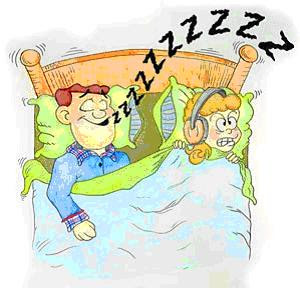Does this image seem familiar to anyone? A snoring bed partner is a common problem! However, the problem may go far beyond nighttime frustration: it may be an indicator of an important medical problem called Obstructive Sleep Apnea.
Obstructive sleep apnea (OSA) is a disorder that is characterized by periods of diminished breathing or pauses in breathing during sleep, caused by repetitive collapse of the upper airway.
Symptoms of sleep apnea include:
- restlessness and snoring during sleep
- awakening with a choking or gasping sensation
- waking feeling unrested
- daytime sleepiness or fatigue
- morning headaches, dry mouth, or sore throat
- poor concentration
- waking frequently to urinate
The number one risk factor for sleep apnea is overweight or obesity: the risk of OSA increases with increasing body weight. Other risk factors include increasing age, male gender, abnormalities of the upper airway, medications that induce somnolence, and alcohol.
Obstructive sleep apnea can be a serious medical problem, as it is associated with an increased risk of high blood pressure, diabetes, heart attack or heart arryhtmias, congestive heart failure, and increased risk of accidental injury and motor vehichle accidents. In patients with untreated severe sleep apnea, the risk of death is 3 to 6 times higher than people without sleep apnea.
Sleep apnea is best diagnosed in a sleep lab, where breathing patterns during sleep are assessed. In-home portable monitoring devices can also be used to make the diagnosis.
In terms of treatment of obstructive sleep apnea, weight loss is an essential component. Weight loss has been shown to decrease the severity of OSA, decrease daytime sleepiness, as well as improve quality of life. Sleeping in positions other than on your back is helpful, but may be difficult to maintain all night. Avoidance of alcohol and sedating medications is of benefit as well.
The most effective mechanical treatment of OSA is a machine that provides positive airway pressure, applied during sleep. By blowing air gently into the airway, the pressure generated helps to keep the airway open and avoid obstruction during sleep. Oral or dental devices are also available that can help alleviate obstruction in some people. For a minority of patients, surgery on the upper airway to help alleviate obstruction can be helpful, but the success rate is generally less than 50%.
Be sure to speak to your doctor if you think that you or your bed partner are at risk!
Doctor Sue © 2010 www.drsue.ca drsuetalks@gmail.com
Follow me on Twitter.com for extra tips and pearls! drsuepedersen












